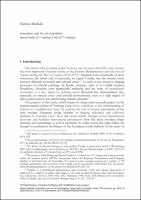Chapter Innovations and the art of deception: mixed cloths in Venetian Crete (17th century)
| dc.contributor.author | Markaki, Tatiana | |
| dc.date.accessioned | 2022-06-01T12:29:34Z | |
| dc.date.available | 2022-06-01T12:29:34Z | |
| dc.date.issued | 2022 | |
| dc.identifier | ONIX_20220601_9788855185653_789 | |
| dc.identifier.uri | https://library.oapen.org/handle/20.500.12657/56605 | |
| dc.description.abstract | This paper investigates innovations of the early modern European textile industry and practices of cultural transfer using seventeenth-century Venetian Crete as a case study. It explores the use of novelties, such as mixed cloths, in the dowries assigned to brides in the urban setting of Candia (modern Heraklion) and the surrounding countryside during the period 1600-1645. It draws on computer-processed data from marriage agreements and inventories of movables from the State Archives of Venice. It illustrates, through a comparative lens, how brides used (silk) mixed fabrics to differentiate themselves from others and how Venetian Crete followed the changes in production techniques of the European textile industry. | |
| dc.language | English | |
| dc.relation.ispartofseries | Datini Studies in Economic History | |
| dc.subject.other | Venetian Crete | |
| dc.subject.other | innovations | |
| dc.subject.other | mixed fabrics | |
| dc.subject.other | cultural transfer | |
| dc.subject.other | seventeenth century. | |
| dc.title | Chapter Innovations and the art of deception: mixed cloths in Venetian Crete (17th century) | |
| dc.type | chapter | |
| oapen.identifier.doi | 10.36253/978-88-5518-565-3.04 | |
| oapen.relation.isPublishedBy | bf65d21a-78e5-4ba2-983a-dbfa90962870 | |
| oapen.relation.isbn | 9788855185653 | |
| oapen.series.number | 2 | |
| oapen.pages | 10 | |
| oapen.place.publication | Florence |

